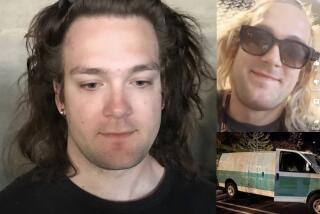Man Convicted in Westwood Auto Rampage Found Sane
- Share via
Despite his mental illness, Daniel Lee Young was legally sane when he drove his brother’s car down a crowded Westwood sidewalk last summer, killing one person and injuring 48 others, a Santa Monica Superior Court jury decided Thursday.
The verdict, reached after more than four days of deliberation, means that Young could face a state prison term of more than 100 years when he is sentenced March 22 by Judge Jacqueline L. Weiss.
Had the jury found Young, 21, of Inglewood, to have been legally insane when he mowed down the pedestrians, he would have been committed to a state mental hospital for an indefinite period and would have been eligible for release if doctors decided that his mental condition had improved.
Jurors earlier had found Young guilty of one count of first-degree murder and 48 counts of attempted murder. Because Young pleaded both not guilty and not guilty by reason of insanity, a second phase of the trial was held to determine Young’s mental state at the time of the incident.
“I’m very pleased with the decision,” said Deputy Dist. Atty. John H. Reid, who prosecuted the case.
Young, dressed in a blue County Jail jump suit, appeared calm as the verdict was read.
“He was really indifferent,” said Young’s attorney, Deputy Public Defender Irwin Pransky. “He stated that he was ready to go to prison. I don’t think he appreciates what that means.” Pransky said he will appeal the sanity finding.
The public defender had argued that Young is a paranoid schizophrenic who, because of his delusions, did not know what he was doing when he drove the car onto the Westwood Boulevard sidewalk on the evening of July 27, the day before the opening of the 1984 Olympics.
Young told police hours after the incident that he drove into the crowd to call attention to what he regarded as a great injustice: a law he believed that Congress had passed requiring him to live in poverty and to write hit songs and movies for others, including Stevie Wonder and Michael Jackson, for which he would receive neither money nor credit.
One juror, Lorena Prichard, said the panel split on the sanity issue on its first two ballots before coming in with a unanimous decision the third time. At one point, the jury asked court reporters to read back the entire testimony of two court-appointed psychiatrists who had examined Young.
“There was a lot of passion involved” in making the decision, Prichard said, “but we had to keep coming back to the law.”
Under California law, the burden of proof during the sanity phase of a trial is on the defense attorney, who must show that his client was neither able to distinguish between right and wrong nor able to understand the nature and quality of his action.
Because of legal questions about that definition raised in pending court cases, Reid and Pransky agreed to a less stringent test: that Pransky would have to prove only one of the two conditions to win an insanity finding. Despite that, the jury sided with the prosecution.
More to Read
Sign up for Essential California
The most important California stories and recommendations in your inbox every morning.
You may occasionally receive promotional content from the Los Angeles Times.










